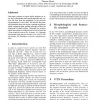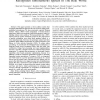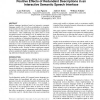2047 search results - page 166 / 410 » The limits of speech recognition |
COLING
1990
13 years 11 months ago
1990
This paper presents a system which analyzes an in'put text syntactically and morphologically and converts the text from the graphemic to the phonetic :representation (or vice...
ICASSP
2011
IEEE
13 years 1 months ago
2011
IEEE
A conditional model is introduced for triggering understanding actions that correct errors of frame hypothesization and composition. Experimental evidence is provided using the Fr...
IROS
2006
IEEE
14 years 4 months ago
2006
IEEE
— This paper presents a robot audition system that recognizes simultaneous speech in the real world by using robotembedded microphones. We have previously reported Missing Featur...
IUI
2009
ACM
14 years 7 months ago
2009
ACM
Spoken language interfaces based on interactive semantic language models [16, 14] allow probabilities for hypothesized words to be conditioned on the semantic interpretation of th...
ICASSP
2011
IEEE
13 years 1 months ago
2011
IEEE
Speech inversion is a way of estimating articulatory trajectories or vocal tract configurations from the acoustic speech signal. Traditionally, articulator flesh-point or pellet t...



